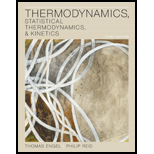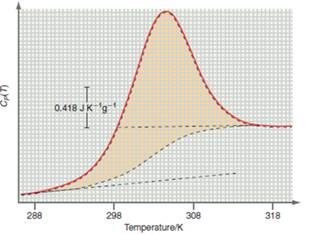
Thermodynamics, Statistical Thermodynamics, & Kinetics
3rd Edition
ISBN: 9780321766182
Author: Thomas Engel, Philip Reid
Publisher: Prentice Hall
expand_more
expand_more
format_list_bulleted
Question
Chapter 4, Problem 4.25NP
Interpretation Introduction
Interpretation:
The change in enthalpy should be calculated between T = 288 K and T = 318 K by using the given DSC data and whether the method is accurate or not should be determined.

Concept Introduction:
The mathematical expression for the standard enthalpy change value at room temperature is:
Where, n and p represents the coefficients of reactants and products in the balanced chemical equation.
The enthalpy change of reaction is calculated by the following expression:
Expert Solution & Answer
Want to see the full answer?
Check out a sample textbook solution
Students have asked these similar questions
Problem 7 of 10
Draw the major product of this reaction. Ignore inorganic byproducts.
S'
S
1. BuLi
2. ethylene oxide (C2H4O)
Select to Draw
a
Submit
Feedback (4/10)
30%
Retry
Curved arrows are used to illustrate the flow of electrons. Use the reaction conditions provided and follow
the arrows to draw the reactant and missing intermediates involved in this reaction.
Include all lone pairs and charges as appropriate. Ignore inorganic byproducts.
Incorrect, 6 attempts remaining
:0:
Draw the Reactant
H
H3CO
H-
HIO:
Ö-CH3
CH3OH2*
protonation
H.
a
H
(+)
H
Ο
CH3OH2
O:
H3C
protonation
CH3OH
deprotonation
>
CH3OH
nucleophilic addition
H.
HO
0:0
Draw Intermediate
a
X
Can I please get the blank spaces answered/answers?
Chapter 4 Solutions
Thermodynamics, Statistical Thermodynamics, & Kinetics
Ch. 4 - In calculating HR at 285.15 K, only the Hf of the...Ch. 4 - What is the point of having an outer water bath in...Ch. 4 - Is the following statement correct? If not rewrite...Ch. 4 - Does the enthalpy of formation of H2Ol change if...Ch. 4 - Why are elements included in the sum in Equation...Ch. 4 - Why are heat capacities of reactants and products...Ch. 4 - Prob. 4.7CPCh. 4 - Prob. 4.8CPCh. 4 - Prob. 4.9CPCh. 4 - Prob. 4.10CP
Ch. 4 - Prob. 4.11CPCh. 4 - Prob. 4.12CPCh. 4 - You wish to measure the heat of solution of NaCl...Ch. 4 - Prob. 4.14CPCh. 4 - Prob. 4.15CPCh. 4 - Prob. 4.16CPCh. 4 - Prob. 4.17CPCh. 4 - Dogs cool off in hot weather by panting. Write a...Ch. 4 - Prob. 4.19CPCh. 4 - Prob. 4.20CPCh. 4 - Given the data in Table 4.1 (Appendix, Data...Ch. 4 - Prob. 4.2NPCh. 4 - A sample of K(s) of mass 2.740 g undergoes...Ch. 4 - Calculate Hf for NO(g) at 975 K, assuming that the...Ch. 4 - Prob. 4.5NPCh. 4 - Derive a formula for HRT for the reaction...Ch. 4 - Prob. 4.7NPCh. 4 - Prob. 4.8NPCh. 4 - Calculate the standard enthalpy of formation of...Ch. 4 - The following data are a DSC scan of a solution of...Ch. 4 - Prob. 4.11NPCh. 4 - Prob. 4.12NPCh. 4 - Prob. 4.13NPCh. 4 - Prob. 4.14NPCh. 4 - Prob. 4.15NPCh. 4 - The total surface area of Asia consisting of...Ch. 4 - Prob. 4.17NPCh. 4 - A sample of Na2SO4s is dissolved in 225 g of water...Ch. 4 - Nitrogen is a vital component of proteins and...Ch. 4 - Prob. 4.20NPCh. 4 - Prob. 4.21NPCh. 4 - A 0.1429 g sample of sucrose C12H22O11 is burned...Ch. 4 - Prob. 4.23NPCh. 4 - Prob. 4.24NPCh. 4 - Prob. 4.25NPCh. 4 - Given the following heat capacity data at 298 K,...Ch. 4 - Calculate H for the process in which Cl2g...Ch. 4 - From the following data at 298.15 K C, calculate...Ch. 4 - Prob. 4.29NPCh. 4 - Use the average bond energies in Table 4.3 I to...Ch. 4 - Prob. 4.31NPCh. 4 - Prob. 4.32NPCh. 4 - Prob. 4.33NPCh. 4 - Prob. 4.34NPCh. 4 - Prob. 4.35NP
Knowledge Booster
Learn more about
Need a deep-dive on the concept behind this application? Look no further. Learn more about this topic, chemistry and related others by exploring similar questions and additional content below.Similar questions
- 1. Identify the following alkenes as E or Z NH₂ Br 2. Draw the structures based on the IUPAC names (3R,4R)-3-bromo-4-fluoro- 1-hexene (Z)-4-bromo-2-iodo-3-ethyl- 3-heptene تر 3. For the following, predict all possible elimination product(s) and circle the major product. HO H₂SO4 Heat 80 F4 OH H2SO4 Heat 어요 F5 F6 1 A DII 4 F7 F8 F9 % & 5 6 7 * ∞ 8 BAB 3 E R T Y U 9 F D G H J K O A F11 F10arrow_forwardDraw the major product of this reaction. Ignore inorganic byproducts. ○ O 1. H₂O, pyridine 2. neutralizing work-up a N W X 人 Parrow_forward✓ Check the box under each molecule that has a total of five ẞ hydrogens. If none of the molecules fit this description, check the box underneath the table. tab OH CI 0 Br xx Br None of these molecules have a total of five ẞ hydrogens. esc Explanation Check caps lock shift 1 fn control 02 F2 W Q A N #3 S 80 F3 E $ t 01 205 % 5 F5 & 7 © 2025 McGraw Hill LLC. All Rights Reserved. Terms of Use | Privacy Center | Accessibility FT * 8 R T Y U כ F6 9 FIG F11 F D G H J K L C X V B < N M H option command P H + F12 commandarrow_forward
- Draw the major product of this reaction. Ignore inorganic byproducts and the carboxylic acid side product. O 1. CHзMgBr (excess) 2. H₂O ✓ W X 人arrow_forwardIf cyclopentyl acetaldehyde reacts with NaOH, state the product (formula).arrow_forwardDraw the major product of this reaction. Ignore inorganic byproducts. N S S HgCl2, H2SO4 く 8 W X Parrow_forward
- tab esc く Drawing the After running various experiments, you determine that the mechanism for the following reaction occurs in a step-wise fashion. Br + OH + Using this information, draw the correct mechanism in the space below. 1 Explanation Check F2 F1 @2 Q W A os lock control option T S # 3 80 F3 Br $ 4 0105 % OH2 + Br Add/Remove step X C F5 F6 6 R E T Y 29 & 7 F D G H Click and drag to start drawing a structure. © 2025 McGraw Hill LLC. All Rights Reserved. Terms of Use | Privacy Ce A F7 DII F8 C Ո 8 * 9 4 F10 F C J K L C V Z X B N M H command P ge Coarrow_forwardIndicate compound A that must react with ethylbenzene to obtain 4-ethylbenzene-1-sulfonic acid. 3-bromo-4-ethylbenzene-1-sulfonic acid.arrow_forwardPart 1 of 2 Draw the structure of A, the minor E1 product of the reaction. esc I Skip Part Check H₂O, D 2 A + Click and drag to start drawing a structure. -0- F1 F2 1 2 # 3 Q A 80 F3 W E S D F4 $ 4 % 5 F5 ㅇ F6 R T Y F G X 5 & 7 + Save 2025 McGraw Hill LLC. All Rights Reserved. DII F7 F8 H * C 80 J Z X C V B N 4 F9 6arrow_forward
- File Preview The following is a total synthesis of the pheromone of the western pine beetle. Such syntheses are interesting both because of the organic chemistry, and because of the possibility of using species specific insecticides, rather than broad band insecticides. Provide the reagents for each step. There is some chemistry from our most recent chapter in this synthesis, but other steps are review from earlier chapters. (8 points) COOEt COOEt A C COOEt COOEt COOH B OH OTS CN D E See the last homework set F for assistance on this one. H+, H₂O G OH OH The last step is just nucleophilic addition reactions, taking the ketone to an acetal, intramolecularly. But it is hard to visualize the three dimensional shape as it occurs. Frontalin, pheromone of the western pine beetlearrow_forwardFor the reaction below: 1. Draw all reasonable elimination products to the right of the arrow. 2. In the box below the reaction, redraw any product you expect to be a major product. C Major Product: Check + ◎ + X ง © Cl I F2 80 F3 I σ F4 I F5 NaOH Click and drawing F6 A 2025 McGraw Hill LLC. All Rights E F7 F8 $ # % & 2 3 4 5 6 7 8 Q W E R T Y U A S D F G H Jarrow_forwardCan I please get help with this graph. If you can show exactly where it needs to pass through.arrow_forward
arrow_back_ios
SEE MORE QUESTIONS
arrow_forward_ios
Recommended textbooks for you
 Principles of Modern ChemistryChemistryISBN:9781305079113Author:David W. Oxtoby, H. Pat Gillis, Laurie J. ButlerPublisher:Cengage Learning
Principles of Modern ChemistryChemistryISBN:9781305079113Author:David W. Oxtoby, H. Pat Gillis, Laurie J. ButlerPublisher:Cengage Learning Chemistry & Chemical ReactivityChemistryISBN:9781337399074Author:John C. Kotz, Paul M. Treichel, John Townsend, David TreichelPublisher:Cengage Learning
Chemistry & Chemical ReactivityChemistryISBN:9781337399074Author:John C. Kotz, Paul M. Treichel, John Townsend, David TreichelPublisher:Cengage Learning General Chemistry - Standalone book (MindTap Cour...ChemistryISBN:9781305580343Author:Steven D. Gammon, Ebbing, Darrell Ebbing, Steven D., Darrell; Gammon, Darrell Ebbing; Steven D. Gammon, Darrell D.; Gammon, Ebbing; Steven D. Gammon; DarrellPublisher:Cengage Learning
General Chemistry - Standalone book (MindTap Cour...ChemistryISBN:9781305580343Author:Steven D. Gammon, Ebbing, Darrell Ebbing, Steven D., Darrell; Gammon, Darrell Ebbing; Steven D. Gammon, Darrell D.; Gammon, Ebbing; Steven D. Gammon; DarrellPublisher:Cengage Learning Chemistry: The Molecular ScienceChemistryISBN:9781285199047Author:John W. Moore, Conrad L. StanitskiPublisher:Cengage Learning
Chemistry: The Molecular ScienceChemistryISBN:9781285199047Author:John W. Moore, Conrad L. StanitskiPublisher:Cengage Learning Chemistry: An Atoms First ApproachChemistryISBN:9781305079243Author:Steven S. Zumdahl, Susan A. ZumdahlPublisher:Cengage LearningChemistry: Matter and ChangeChemistryISBN:9780078746376Author:Dinah Zike, Laurel Dingrando, Nicholas Hainen, Cheryl WistromPublisher:Glencoe/McGraw-Hill School Pub Co
Chemistry: An Atoms First ApproachChemistryISBN:9781305079243Author:Steven S. Zumdahl, Susan A. ZumdahlPublisher:Cengage LearningChemistry: Matter and ChangeChemistryISBN:9780078746376Author:Dinah Zike, Laurel Dingrando, Nicholas Hainen, Cheryl WistromPublisher:Glencoe/McGraw-Hill School Pub Co

Principles of Modern Chemistry
Chemistry
ISBN:9781305079113
Author:David W. Oxtoby, H. Pat Gillis, Laurie J. Butler
Publisher:Cengage Learning

Chemistry & Chemical Reactivity
Chemistry
ISBN:9781337399074
Author:John C. Kotz, Paul M. Treichel, John Townsend, David Treichel
Publisher:Cengage Learning

General Chemistry - Standalone book (MindTap Cour...
Chemistry
ISBN:9781305580343
Author:Steven D. Gammon, Ebbing, Darrell Ebbing, Steven D., Darrell; Gammon, Darrell Ebbing; Steven D. Gammon, Darrell D.; Gammon, Ebbing; Steven D. Gammon; Darrell
Publisher:Cengage Learning

Chemistry: The Molecular Science
Chemistry
ISBN:9781285199047
Author:John W. Moore, Conrad L. Stanitski
Publisher:Cengage Learning

Chemistry: An Atoms First Approach
Chemistry
ISBN:9781305079243
Author:Steven S. Zumdahl, Susan A. Zumdahl
Publisher:Cengage Learning

Chemistry: Matter and Change
Chemistry
ISBN:9780078746376
Author:Dinah Zike, Laurel Dingrando, Nicholas Hainen, Cheryl Wistrom
Publisher:Glencoe/McGraw-Hill School Pub Co
The Laws of Thermodynamics, Entropy, and Gibbs Free Energy; Author: Professor Dave Explains;https://www.youtube.com/watch?v=8N1BxHgsoOw;License: Standard YouTube License, CC-BY